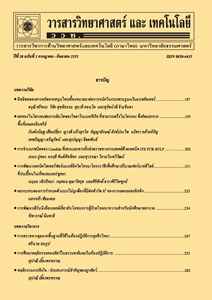การบำบัดน้ำสีรีแอคทีฟบลูความเข้มข้นสูงด้วยปฏิกิริยาเฟนตันและเสมือนเฟนตันที่ใช้ผงตะไบเหล็ก
Main Article Content
Abstract
Abstract
This research aimed to remove the reactive blue dye in the concentrations as high as 1,000-3,000 mg/L by using Fenton and Fenton-like processes. Ferrous sulfate was used in the Fenton, while iron filings in the size of <38, 38-45, 75-90 micron, and mixed size were used in the latter. The study was started from finding the optimum pH from 2.0 to 3.0, the optimum iron concentration, and then the optimum mole ratio of Fe : H2O2 within 3 hours of treatment duration. The results revealed that the optimum pH was 2.0 in both processes. The optimum iron concentrations for the dyes concentrations of 1,000, 2,000 and 3,000 mg/L were 6, 11, and 14 mM, respectively. The mole ratio of Fe:H2O2 as 6 : 60 and 11 : 110 mM were the best for both processes to remove the dye concentrations of 1,000 and 2,000 mg/L, respectively. For the dye concentration of 3,000 mg/L, a 14 : 140 mM was the best ratio for Fenton-like process and a 14 : 560 mM was the best ratio for Fenton process. Dye treatment with Fenton was much faster than with Fenton-like in a 3-hr treatment although the removal efficiency was similar, 99.4-99.8 %. However, with the chain reactions when the treatment duration was as long as 35 hours, the Fenton-like process with mixed size of iron filings could be comparable to Fenton. Therefore, the usage of iron filings could be considerable in dye treatment with the cheaper cost than using ferrous sulfate.
Keywords: Fenton; Fenton-like; iron filing; reactive blue dye
Article Details
References
[2] Panswad, T. and Lunagdilok, W., 2000, Decolorization of reactive dyes with different molecular structures under different environmental conditions, Water Res. 34: 4177-4184.
[3] Kušić, H., Božić, L. and Koprivanac, N., 2007, Fenton type processes for minimization of organic content in colored wastewaters: part I: processes optimization, Dyes Pigments 74: 380-387.
[4] Hassan, H. and Hameed, B.H., 2011, Fe-clay as effective heterogeneous Fenton catalyst for the decolorization of reactive blue 4, Chem. Eng. J. 171: 912-918.
[5] Zhang, H., Zhang, J., Zhang, C., Liu, F. and Zhang, D., 2009, Degradation of C.I. Acid Orange 7 by the advanced Fenton process in combination with ultrasonic irradiation, Ultrasonics Sonochem. 16: 325-330.
[6] Neamtu, M., Yediler, A., Siminiceanu, I. and Kettrup, A., 2003, Oxidation of commercial reactive azo dye aqueous solutions by the photo-Fenton and Fenton-like processes, J. Photochem. Photobiol. A Chem. 161: 87-93.
[7] Nidheesh, P.V., Gandhimathi, R. and Ramesh, S.T., 2013, Degradation of dyes from aqueous solution by Fenton processes: A review, Environ. Sci. Pollut. Res. 20: 2099-2132.
[8] Walling, C., 1975, Fenton’s reagent revisited, Acc. Chem. Res. 8: 125-131.
[9] Tang, W.Z. and Chen, R.Z., 1996, Decolorization kinetics and mechanisms of commercial dyes by H2O2/iron powder system, Chemosphere 32: 947-958.


